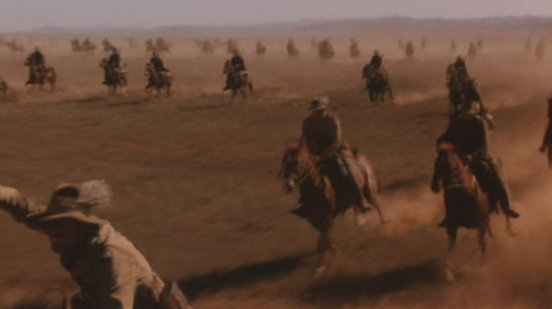Clip description
The 4th and 12th Regiments of the 4th Australian Light Horse Brigade have formed into three lines. Lieutenant-Colonel Bourchier (Tony Bonner) leads them off, from a walk to a canter, maintaining the lines. The Turkish observers radio to their commander (Gerard Kennedy) that the Australians appear to be ready to charge, but the German officer contradicts that assessment. He believes they will not charge, because they have not done so before. In the Turkish trenches, another officer believes the Australians will dismount to fight on foot. The artillery is caught unaware as Lieutenant-Colonel Bourchier orders his men to charge. Five hundred horses and men gallop towards the Turkish guns.
Curator’s notes
The movie exists to depict this charge, so the way it was filmed had to be exemplary, and it was. The sequence builds superbly, with virtually no dialogue, as the men form ranks behind a hillock. They must cross three kilometres of open ground towards trenches protected by artillery and machine guns. The conventional wisdom is that such a charge is madness – old-fashioned ‘cavalry’ is no match for modern machine guns. Lt-Gen. Sir Harry Chauvel has no option. Beersheba must be taken before nightfall or his men and horses will have no water.
These sequences were shot outside Hawker in South Australia. Horses and riders had been in training for several months. Some horses were trained to fall on command, but the filmmakers claim that no horse was injured in the making of the film. Compare this sequence with that shot by Charles Chauvel – clip three of Forty Thousand Horsemen, in 1940. Chauvel was able to call on advice from men who had taken part in the actual charge. There were few of these left by 1987, but this production has far more sophisticated tools to work with. Note the crane shot at speed just after the order to charge, an extremely difficult shot to do on the run. The effect is superbly controlled by Adrian Carr’s editing, which holds back the action and speed, in order to further the suspense. It is a brilliantly constructed finale and largely accurate, thanks to the persistence of the screenwriter and co-producer Ian Jones, who originated the project.



